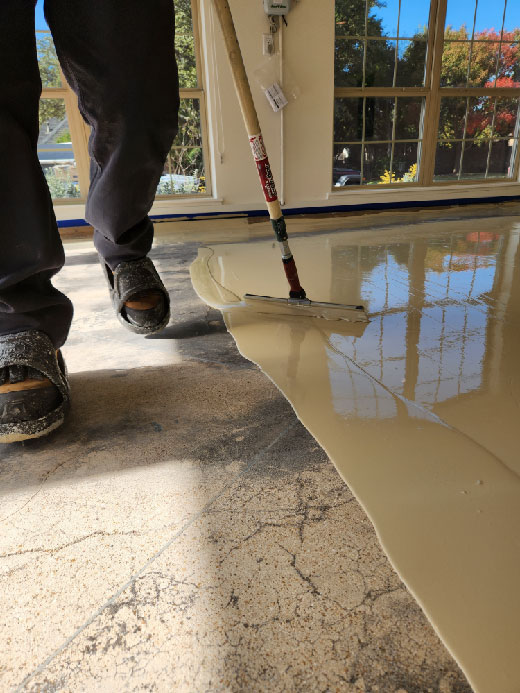
Thinking about Polyaspartic Floor coating? Good news: it’s a great choice and costs about $5 to $12 per square foot. Check out our guide for the quick, important details on these floors, so you can decide without the extra fluff.
Whether you’re a homeowner seeking durability and aesthetics or a business owner aiming to enhance your space, this guide will provide clear insights into the benefits and applications of polyaspartic coatings.
Polyaspartic coatings are a durable and versatile type of flooring material, perfect for garages, industrial areas, and commercial spaces. Part of the polyurea family, these coatings set quickly and resist chemicals, UV damage, and wear, while maintaining a shiny finish. They’re ideal for upgrading concrete floors, offering a smooth, easy-to-maintain surface that handles heavy use and tough conditions.
Polyaspartic coatings were originally developed in the 1990s to protect steel from corrosion.
Despite the fact that polyaspartic coating is relatively new to the market, there are several obvious advantages that come with opting for this type of garage floor coating over epoxy sealants. Consider some of the following pros and cons of polyaspartic vs. epoxy garage flooring:
Polyaspartic coating will create a hard, yet flexible finish that will not chip, scratch, or become dusty over time. The rigid texture of epoxy finishes, on the other hand, are prone to abrasion and chipping only a couple years after installation.
Polyaspartic coatings have the unique quality of an extremely rapid drying time. One coat of polyaspartic finish can dry in as little as on hour. This means that the several coats used to completely seal your garage floor will be completely dry and ready to use on the same day the project is started. With epoxy garage floor sealants, however, just one layer can take around 16 hours to dry. This means that homeowners will often have to wait up to a week in order for the epoxy coating to properly dry. Trying to find a proper
place to park your cars and store your tools and other items warehoused in your garage during this drying period can be a frustrating challenge.
For health-conscious homeowners, polyaspartic coatings also offer a much safer way to seal the concrete floor in your garage. Epoxy coatings are known to off-gas dangerous volatile organic compounds (VOCs). In fact, the toxic cure times associated with epoxy flooring pose another time constraint as work crews generally have to suspend all work on a jobsite during the 72 hour off-gassing cure period for new epoxy installations. With polyaspartic coatings, homeowners can rest assured that your home´s indoor air quality will be protected. Polyaspartic coatings have virtually no odor, no off-gassing, and low to zero VOC levels.
Lastly, polyaspartic coating also offer superior UV stability. Essentially, this means that polyaspartic coatings will never turn yellow or fade when regularly exposed to sunlight. For garage floors that are sealed with epoxy coatings, extended exposure to the UV rays from the sun often leads to unappealing yellowing and fading which ruins the aesthetics of your garage floor.
Choosing to install this coating offers the fastest, safest, most durable, and most customizable option for your concrete garage floor. With a polyaspartic coatings and topcoats, the person applying the coat can methodically control the rate of cure to ensure the most efficient dry time without compromising the thickness or durability of the sealant. Furthermore, the low VOC content associated with polyaspartic garage flooring coatings makes them the safest option in regards to indoor air condition.
Choosing between polyaspartic and epoxy for your garage floor? Let’s break down the costs. Polyaspartic coatings, known for their durability and quick curing, might cost a bit more upfront. Expect around $6-7 per square foot for a partial system, which includes a polyurea or epoxy base with a polyaspartic top coat. A full system, with both base and top coats of polyaspartic, can be in the range of $8 to $12 per square foot.
Epoxy systems can be cheaper, especially if you go the DIY route, costing about $1 per square foot. For professional installation, prices can reach up to $5 per square foot. Though epoxy initially seems budget-friendly, it can lead to higher costs over time due to more frequent maintenance and repairs.
And here’s something to consider: with MyGarageFloors.com, you can get the highest quality polyaspartic system for a price comparable to epoxy. This offers a great balance of quality and value, giving your garage floor a durable, long-lasting finish without breaking the bank.
Polyaspartic floor coatings offer rapid curing times and excellent durability but require a level of knowledge that makes them less suitable for DIY projects, unlike more forgiving materials like epoxy floor coating.
These coatings demand meticulous surface preparation, special machinery, exact mixing ratios, and quick, efficient application. This precision helps avoid common pitfalls such as uneven coverage or premature curing.
Additionally, the cost of high-quality polyaspartic coatings is quite high, as most big box stores do not carry them. In reality, attempting a DIY application of polyaspartic coatings is likely to be more expensive than hiring a professional company. This makes professional installation not just a convenience but a cost-effective choice as well.
polyaspartic floor coating are renowned for their exceptional long-lasting durability. They can withstand heavy foot traffic, vehicle movement, impacts from dropped tools or equipment, and other daily wear and tear, ensuring your garage floor remains pristine for years.
These coatings provide excellent resistance to chemicals, oil, grease, and other substances commonly found in garages. This resistance prevents stains and damage to the floor, making cleanup easier and maintaining a clean appearance.
Polyaspartic coatings have a rapid curing process, which means your garage floor can be ready to use much faster compared to other coating options. This minimizes downtime and inconvenience during the installation process.
Polyaspartic coatings are UV stable, meaning they won’t fade, discolor, or deteriorate when exposed to sunlight. This feature is especially important if your garage has windows or is frequently exposed to natural light.
These coatings provide a glossy and reflective finish that enhances the appearance of your garage. The high gloss adds a professional and polished look to the space, elevating its overall aesthetic.
Polyaspartic coatings create a seamless surface without joints or seams where dirt and debris can accumulate. This makes cleaning a breeze, as you can easily sweep or mop the floor without Due to their durability and resistance to various forms of damage, polyaspartic floor coating have a longer lifespan compared to some traditional coating options, reducing the need for frequent recoating or repairs.
While commonly used in garages, polyaspartic coatings are versatile and can be applied to various surfaces, including concrete, wood, and metal. This opens up possibilities for using them in other areas of your property as well.
Polyaspartic coatings can withstand a wide range of temperatures, making them suitable for use in both hot and cold climates without cracking or deteriorating.
Thanks to their resistance to stains, chemicals, and UV damage, polyaspartic-coated floors require minimal maintenance. Regular sweeping and occasional mopping are typically sufficient to keep the floor looking great.
Polyaspartic coatings can be customized with various colors, patterns, and textures to suit your preferences and match your garage’s overall design.
While the initial investment in polyaspartic floor coating might be higher than some traditional options, their longevity, low maintenance requirements, and reduced need for repairs can lead to long-term cost savings.
If you’re interested in high-quality polyaspartic floor coatings and are looking for professional installation services near you, look no further. We pride ourselves on employing in-house, well-trained installers who are experts in applying polyaspartic floor coatings. Our team ensures that every project is executed with precision and skill, resulting in a durable and visually appealing finish.
We handle all installations directly, which means you can expect consistent, high-quality service across all our locations. Whether you’re upgrading your garage, commercial space, or industrial area, our professional staff is equipped to provide top-notch installation.
To find the closest service provider and get your project started, please visit our locations page by clicking on this link: Find Our Locations. Here, you’ll find information on all our locations, ensuring that professional help is just a click away.
The success of any coating application begins with thorough surface preparation. This includes cleaning the garage floor to remove dust, dirt, oil, grease, and any other contaminants. The floor might also need to be mechanically profiled using methods like shot blasting or diamond grinding to create a rough texture that allows the coating to adhere effectively.
Any cracks, pits, or surface imperfections should be repaired and patched using appropriate materials. This step ensures a smooth and even surface for the polyaspartic coating to be applied.
The first layer of polyaspartic base coat is applied evenly across the floor. This layer acts as a foundation for subsequent coats and provides the color base for the finished floor.
If you’re opting for decorative elements such as color chips or quartz, they are broadcast onto the wet base coat. This not only adds aesthetics but also contributes to texture and slip resistance.
The final layer, known as the top coat, is applied. This layer provides additional protection, UV resistance, and a glossy finish. It’s important to ensure a smooth and even application to achieve the desired appearance.
The polyaspartic coating has a relatively fast curing time, which means it dries quickly. However, it’s crucial to follow the recommended curing times provided by the manufacturer to ensure the coating fully cures and bonds properly.
Once the coating has cured, the garage floor can be ready for light foot traffic within a few hours. Heavy objects and vehicles can typically be placed on the floor after a day or two, depending on the manufacturer’s recommendations.
Mygaragefloors.com is an online platform with in-house installers dedicated to helping homeowners upgrade their garage floor with a superb Polyaspartic floor coating at the lowest price in the nation.
Stop wasting time on sales meetings.
Save your time and avoid their commission. Get your garage floor coatings installed today at the lowest price.
Service areas
Check pricing
469-990-9990
Mygaragefloors.com is an online platform with in-house installers dedicated to helping homeowners upgrade their garage floor with a superb Polyaspartic floor coating at the lowest price in the nation.



Lots of companies claim to use Polyaspartic, but they only apply it for the final coat.
Using a mix of Epoxy or Polyurea for the base coat can lead to yellowing and peeling over time.
Insist on a full Polyaspartic system for both base and top coats.